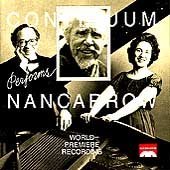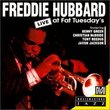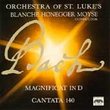| All Artists: Nancarrow, Seltzer, Sachs, Continuum Title: Orchestral, Chamber & Piano Music Members Wishing: 0 Total Copies: 0 Label: Music Masters Jazz Release Date: 4/5/1994 Genres: International Music, Classical Styles: Latin Music, Tango, Chamber Music, Forms & Genres, Sonatas, Historical Periods, Modern, 20th, & 21st Century, Instruments, Strings Number of Discs: 1 SwapaCD Credits: 1 UPC: 016126706825 |
Search - Nancarrow, Seltzer, Sachs :: Orchestral, Chamber & Piano Music
 | Nancarrow, Seltzer, Sachs Orchestral, Chamber & Piano Music Genres: International Music, Classical |
Larger Image |
CD DetailsSimilar CDs
|
CD ReviewsNancarrow without the player piano: an essential addition to Discophage | France | 10/31/2007 (5 out of 5 stars) "Recorded in 1989, This is the original 1991 release, by Musicmasters, of a CD that was recently reissued by Naxos and is available cheaper in that form (Nancarrow: Pieces Nos. 1 & 2; ¿Tango?; String Quartet No. 1). It is a fascinating addition to our knowledge of Nancarrow, as it gathers most of the (few) pieces he wrote for "normal" instruments, e.g. live performers, as opposed to the mechanical player piano for which he belatedly became so famous. Other than, perforce, the pieces he composed subsequently to the present recording (such as the Canons for Ursula Oppens or the third String Quartet), absent are the two remaining movements of the early (1942) Trio for Clarinet, Bassoon and Piano whose first movement is featured here: they were considered lost and were rediscovered shortly after the recording was made.
Piece No. 1 for Small Orchestra dates from 1943 and, in its perky orchestration and dynamic rhythms, I hear whiffs of Milhaud (Saudades do Brasil comes to mind at 2:50) and Weill. Likewise the Trio movement has the bounce and verve of Milhaud - but these two compositions are hardly essential and typical Nancarrow. They are short, too (7' and 2'30 respectively). The Toccata for Violin and Player Piano is apparently the odd-piece out here in its use of the mechanical piano. In fact, it was first written (in 1935) for "normal" piano but some of the repeated notes in the piano part appeared unplayable, so Nancarrow made a piano roll transcription, and this is what is played here. It is a dazzling, and all-too-short tour de force, with the customary demented boogie-woogie from the piano, and a violin part that first seems to remember Bartok but then just tries to hang in there, attempting to emulate the piano. Violinist Mia Wu doesn't play with a particularly silky tone, but it hardly matters in that music. Unfortunately we are not told on whose and which player piano it was recorded - while retaining a wonderful honky-tonk flavor it sounds more mellow, not as brittle as the one of Nancarrow used for the Wergo 1988 recording of the complete Studies (Nancarrow: Studies for Player Piano). In the 1935 "Prelude" and "Blues" the fingers are Cheryl Seltzer are no match for the machine (which can be heard on the fascinating transcriptions made by Nancarrow and now available from Other Minds on a disc called Conlon Nancarrow : Lost Works, Last Works), but for human appendixes they are superbly fleet, lithe and muscular, much more than the teutonically heavy-handed Henck (and much better recorded too) on Piano Music by Nancarrow and Antheil. The 1943 Sonatina was first written for piano but appeared to be unplayable as such. Here too, Nancarrow made a transcription for player piano, just to be able to hear the piece (all these informations come from the fascinating Other Minds disc mentioned above). It was also later transcribed for piano four-hands by Yvar Mikhashoff, and this version Nancarrow reportedly came to prefer. It is the one played here, and it sounds more mellow than with the player piano, not only because of the slower tempo, but also because of the sound of the grand piano as opposed to the brittle, honky-tonk upright instrument of Nancarrow. The middle blues comes out more bluesy, but Nancarrow's characteristic terraced dynamics don't register as well as on the mechanical instrument. MDG is in the process of recording Nancarrows piano rolls adapted to a modern grand piano, and if they ever come around to the Sonatina, maybe we'll get the best of both worlds (Player Piano 1: Nancarrow Vol. 1). Yet as it is, it is perfectly valid and fun in its own right. Another Mikhashoff transcription for piano four-hands it that of the original player piano Study #15, one that is accessible to live performers. It is a tribute to Joël Sachs' and Cheryl Seltzer's dazzling virtuosity that they do match the machine here. When available, it is quite fascinating to compare these "live" performances to the transcriptions Nancarrow made for the player piano as documented on the Other Minds disc, and the two are really complementary. Nancarrow made such a transcription for the two outer movements of the 1st String Quartet. The difference is not only the obvious one of timbre, but also, once more, of tempo. One understands what Nancarrow had in his "mind's ear" when composing these pieces and hence, why he grew dissatisfied with human performers. The String Quartet played on four strings sounds like, well, just any other string quartet, one that possibly Milhaud (the dynamic bounce, the polytonal impression) or Krenek (the stern canons) and many other 20th century composers of mildly modernist ilk might have written. It its player piano transcription, it sounds like a dazzling, demented study for machine-keyboard. After Nancarrow was discovered by the wider music world in the early `80s, he was persuaded to return to composing for "live" instruments. One of such pieces was the Piece for Small Orchestra No. 2. Not surprisingly, the piano features prominently, especially in a middle off-beat cadenza against jazzy double bass pizzicati (4:27). Overall it is fascinating and slightly jarring to hear all the characteristics of a Nancarrow player piano Study donning orchestral colors - it sounds in fact like the orchestration of a Study and again it is telling that Nancarrow transcribed the second part (starting at 5:50) for player piano (Study #50). But where the player piano has greyer colors and a mechanical and almost abstract quality, the orchestral colors highlight its simple theme of almost coplandesque, prairie-style contour (rising and descending minor thirds that in the transcription are hardly distinguishable from the surrounding activity), whose powerful crescendo give it a surprising "American Epic" quality, offset by the bustling activity of its inner fillings. The only regret one can have is that each piece individually is so short, as well as the disc overall (44:36). " |



